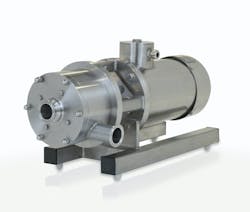The technology for manufacturing-grade mixers hasn’t changed much over the years.
In fact, when manufacturers are shopping for mixers, they often want to purchase an exact replica of a mixer they invested in years ago. This is often the case because changes to equipment could require that the manufacturer go through the process of revalidating it through the U.S. Food and Drug Administration.
“Changes to mixing equipment are typically slow, mostly with minor changes to make improvements,” explains David Dickey, founder of MixTech, an engineering consulting firm specializing in mixing technology and equipment. “Many equipment requests from pharmaceutical companies are for identical equipment purchased previously.”
But this doesn’t mean that vendors are not working to continuously update and tweak the design of mixers to meet the evolving needs of manufacturers. And when a company is shelling out a large investment for a new piece of equipment that will hopefully stand the test of time, it’s important to get the purchase right.
Here are some of the issues facing pharma manufacturers looking to purchase a mixer and how vendors are rising to the challenge.
Common Problems
Most pharmaceutical manufacturers face similar issues when shopping for mixers, according to Rick Earley, the national sales manager for Admix.
These “process pain points” include:
- Long batch times
- The ergonomics and safety of batch operators dumping bags or pails of ingredients into tanks from elevated platforms
- Consistently producing uniform batches with 100 percent utilization of all functional ingredients
- Dusting
- Air entrainment
To help combat those common challenges, Earley recommends that companies look for mixers that reduce batch times by completing all ingredient wetting and dispersing in-line “without the need to wait on conventional tank mixers to complete the job.” Unlike open-air tanks, in-line mixing also ensures that no air is added to the product and eliminates the dusting problems that arise when products are dumped into the tank.
Mixers with floor-level hoppers are also safer to use because operators won’t have to climb stairs with heavy bags and pails.
Earley notes that Admix’s Fastfeed powder induction and dispersion unit includes all of these features and that the system “inducts, wets and disperses from the hopper at the same rate each time, virtually eliminating batch-to-batch inconsistencies that result when operators dump powders into tanks at different rates.”
The Need for Clean
Sanitation is, of course, always of the upmost importance to drugmakers, and sanitation regulations are only getting stricter.
“To respond to legislative and customer requirements, the pharmaceutical industry is having to demand ever-increasing standards of sanitary construction in mixing and processing equipment,” explains Matt Smith, a sales director at Silverson Machines.
Smith recommends that manufacturers look for ultra-sanitary mixing equipment specifically aimed at the pharmaceutical and biotechnology industries.
“Certified by regulatory standards such as 3-A and cGMP, all of Silverson’s mixers can be designed or modified for ultra-sanitary applications, including mixing sterile ingredients, vaccines, ointments, suspensions and injectables,” Smith says. “The mixers feature a minimized number of product contact parts, crevice-free construction and sanitary shaft sealing.”
Good Communication
Although mixing technology has mostly stayed consistent in recent years, the needs of manufacturers are becoming increasingly complicated. This complexity makes it all the more important to make sure your company is clearly communicating its unique process specifications to vendors.
“This has to do with new kinds of medicines that are being developed, such as liquids, ointments and gels,” says Dickey. “New products and processes often have different physical properties or different mixing requirements. These days, typical problems involve non-Newtonian viscosity, powder and liquid addition, powder blending of minor ingredients, and scaling up production.”The Silverson Ultra Sanitary In-Line is a multipurpose high shear mixer designed for clean-in-place and sterilize-in-place operation.
Dickey recommends that manufacturers work meticulously to make sure they are on the same page with mixer vendors to ensure they get equipment fit for their needs. Mixer vendors also often have the right expertise to help manufacturers solve processing issues with their products.
Christine Banaszek, a sales manager at Charles Ross & Son Company, also stresses the importance of communication.
In an attempt to achieve greater batch-to-batch consistency, more customers are standardizing on PLC-based recipe controls, says Banaszek. This level of automation often necessitates extensive integration, and the best way to ensure a smooth start-up upon delivery of your mixer is to source the control system direct from the equipment manufacturer.
“At Ross, we have our own controls division, which oversees the engineering, design and production of all control systems for Ross mixers and blenders.”
Ultimately, Banaszek says that Ross works closely with the end-user to “identify opportunities to streamline the mixer/control design, ensure compliance to code requirements, and to provide smooth, intuitive interfacing with upstream/downstream equipment and mobile devices.”
“No one size fits all,” Banaszek says, explaining that Ross offers customized programming and HMI configuration, as well as software and data logging options.



